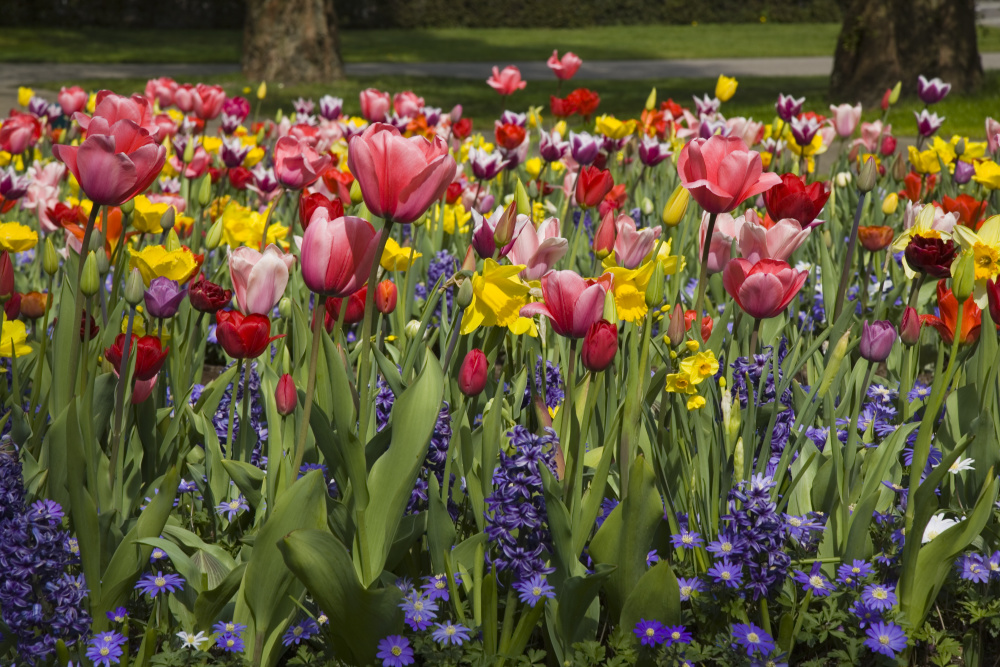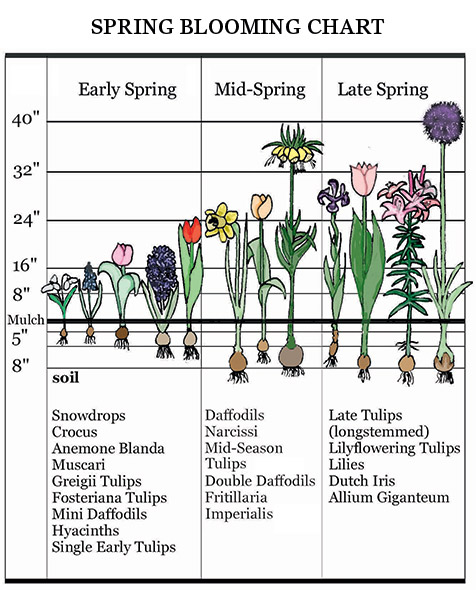To better determine when to plant spring bulbs, there are a few factors to consider that can help ensure a successful and beautiful bloom. First of all, it’s important to take into account the climate of your USDA zone. Different bulbs have different temperature requirements, so understanding the average daily temperatures during the planting season is crucial to determine when to start planting flowers for spring.
In addition, the type of bulb you choose will play a role in determining the ideal planting time. Some bulbs prefer to be planted in early fall, while others can be planted as late as early winter. Lastly, think about the desired bloom time. If you want your flowers to open in early spring, it may be best to plant bulbs that require shorter chilling periods.
On the other hand, if you desire a later blooming period, opt for bulbs that need more chilling time. By considering these factors and doing a little research, you’ll be able to find the perfect timing for planting spring bulbs and enjoy a vibrant and colourful garden come springtime.
When to Plant Spring Bulbs
Planting spring bulbs like daffodils, tulips, hyacinths, crocus, snowdrops, and alliums is an exciting way to bring vibrant colours and fresh scents to the garden. The timing for planting can vary slightly depending on your climate and the specific bulb variety, but a general rule of thumb is to plant them in the fall before the first frost. This allows the bulbs to establish roots before winter sets in. Daffodils, tulips and snowdrops are typically planted in late summer to early fall, while hyacinths and crocus can be planted in early to mid-fall. We recommend planting alliums sometime during fall.
When it comes to planting spring bulbs, there are a few factors to consider. First off, take a look at your climate. Different bulbs have different temperature requirements, so make sure the conditions are right for the specific type of bulb you’re planting. Next, think about the desired bloom time. If you want your bulbs to flower early in the spring, you’ll need to plant them in the fall. On the other hand, if you’re looking for a later blooming period, you may be able to wait until late winter or early spring to plant. Lastly, don’t forget to consider the type of bulb you’re working with. Some bulbs require a period of cold dormancy before they can sprout and bloom, while others prefer warmer temperatures.
If you’re looking to extend the bloom time of your fall-planted, spring-flowering bulbs, here are a few tips. First, make sure to plant a variety of bulbs with staggered bloom times. This way, you’ll have flowers popping up throughout the spring season. Secondly, try deadheading any faded blooms as soon as they start to wither. This will redirect the energy back into the bulb and encourage more blooms. Finally, to enjoy a longer display of flowers, consider planting your bulbs in different locations with varying amounts of sunlight exposure. Some bulbs prefer full sun while others thrive in partial shade.
How to Plant Spring-Flowering Bulbs
Planting spring bulbs is a delightful way to add bursts of colour and beauty to your garden. To ensure the best results, it’s important to follow a few key steps. First, dig a hole that is two to three times deeper than the bulb’s height. This will provide enough space for the bulb to establish its roots and grow properly. As for spacing, bulbs should be planted at least two to three times their width apart, to allow for adequate air circulation and prevent overcrowding.
When it comes to garden tools, you’ll need a trowel or a bulb planter to dig the holes. A trowel is versatile enough to be used for various gardening tasks, while a bulb planter is specifically designed to create perfect holes for bulbs. Both options work well, depending on your preference.
After planting, caring for spring bulbs is relatively easy. They should be watered regularly, especially during dry spells, but avoid overwatering to lessen the possibility of rotting. Applying a slow-release fertilizer, such as Breck’s Food for Bulbs and Perennials, in early spring can also help promote healthy growth and vibrant blooms.
Finally, let’s talk about common mistakes to avoid when planting spring bulbs. One mistake is planting bulbs too shallow or too deep. Follow the recommended depth guidelines for each type of bulb to ensure they have enough nutrients and protection from frost. Another mistake is not giving fall-planted bulbs enough time to establish their roots before cold weather sets in. Planting bulbs in early fall, in the best soil conditions, allows them ample time to develop strong root systems before winter arrives.
By following these tips and taking care of your spring bulbs properly, you’ll be rewarded with a stunning display of flowers that will brighten up your garden year after year.
How to Store Spring Bulbs Before Planting
When it comes to storing your spring-flowering bulbs, there are a few key things to keep in mind. First and foremost, you’ll want to use a breathable material, such as paper bags or mesh containers, to allow for air circulation and prevent mold and fungal growth during bulb dormancy. It’s also important to store your bulbs in a cool, dry place with a consistent temperature of around 50–60° F. Avoid freezing temperatures at all costs, as this can kill the bulb. As for the length of time to store them, aim for no more than a few months before the ideal planting time in your hardiness zone. Remember to keep bulbs in a dark place to prevent any premature sprouting. By following these simple tips, you can ensure that your spring bulbs stay in optimal condition until it’s time to plant them and enjoy their beautiful blooms!
Miss the Fall Planting Window? There’s Still Hope!
If you happen to miss the recommended planting time for your bulbs, don’t worry: there are still options for you. If the ground isn’t frozen over yet, you can still go ahead and plant those bulbs even if it’s in late fall. Just make sure to get them in the ground as soon as possible.
Now, if the ground is already frozen, you have a couple of options. One is to fill your containers with potting soil and force the bulbs indoors. This way, they can still grow and bloom beautifully.
Another option, if you really want to plant those spring bloomers outside above frozen ground, is to add about 8″ of soil on top of them. However, be aware that this might make them more susceptible to being eaten by rodents. To protect your precious bulbs, consider using chicken wire around the planting area.
Should you miss the recommended planting time, don’t fret! There are always ways to work around it and still enjoy a beautiful display of flowers in spring.
Protecting Your Spring-Flowering Bulbs During Winter
Spring-flowering plants are a joy to behold but unfortunately, they can sometimes fall victim to pests and diseases. When it comes to spring-flowering bulbs, some of the most common pests include deer, rabbits, squirrels, slugs, snails and aphids. Left unchecked, these critters can wreak havoc on your beautiful blooms. On the disease front, botrytis blight, downy mildew and tulip fire are among the most common culprits that can damage your spring flowers.
But fear not! There are several methods you can use to control these pests and diseases. Cultural controls such as proper plant spacing and good sanitation practices can help prevent infestations. One of the key tips is to plant bulbs in the right location. Choose a spot that receives adequate sunlight and has well-drained soil, to ensure healthy growth. It’s also helpful to select varieties that are resistant to common pests and diseases. Controls like insecticides and fungicides can be used, if necessary, but always follow instructions carefully. For those looking for a more eco-friendly approach, biological controls like beneficial insects or natural predators can help keep pest populations in check.
By being vigilant and taking proactive measures, you can ensure that your spring-flowering plants stay healthy and vibrant all season long!
Conclusion
In this blog entry, we have explored various topics, such as when to plant bulbs for spring, tips for successful planting, how to store bulbs, what to do if you miss fall planting season, and how to protect your spring-blooming bulbs during winter. We hope that you found these insights helpful and inspiring for your own gardening endeavors. To continue your gardening adventure, be sure to check out our website where you can find a wide selection of high-quality plants, tools, and accessories. Whether you’re a seasoned gardener or just starting out, Breck’s not only has new fall planting bulbs but everything else you need to cultivate a beautiful and bountiful garden. Happy gardening!




